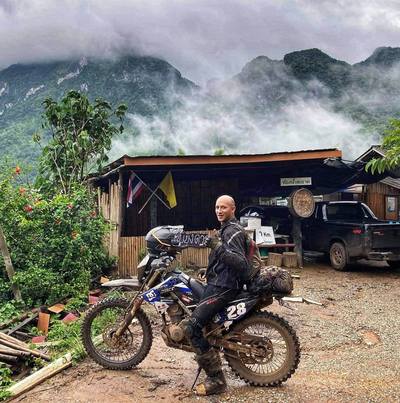Passionate motorcycle riders spend a lot of refreshing time enjoying long rides in open air and being at the disposal of changing weather. The vagaries of the weather can be very challenging especially when you are caught in heavy rains or long days in wet conditions. For these kind of situations, waterproof gear is a crucial piece in a rider’s experience. Especially for your adventure motorcycling pants.
However, in time, the exterior waterproof layer of your biker jeans / pants or jacket can be lost because of the wear. At first rain or at first rainy ride there could be a lot of soaking in the material and make the piece of clothing heavy and wet. Therefore, it can be very useful to know how to waterproof your clothes so you can be dry and comfy without wishing for the rain to stop.
There are several ways you can waterproof your out-clothes such as trousers, coats, jackets, overalls, gloves and headgear. This article is meant to help you learn about different methods of waterproofing and choose the one that suits you best. So here is how you can waterproof your motorcycle clothing:
The Spray Method
-
Start on a Clean Fabric :
This is rule number one for any method you will chose. It is very important for the spray to be applied on a clean surface otherwise it will affect the adhesion. So, start by washing your piece of gear. In case the clothing cannot be washed, try cleaning it with a vacuum or a brush in order to remove any dust or small soil particles from it. -
Make Sure the Cloth is Dry :
The dry factor is also important for the spray to adhere. If you want the spray to stick and make a good sealing, you must make sure the material is not wet in any way. Check the material for any folds or creases and stretched them out so that the spray can go evenly.
-
Apply the Spray in a Well-Ventilated Space :
Work with an opened window, or, if it possible, work outside. Spray the clothes evenly from around 15-20 cm away. If you want to make sure the pungent spray does not affect your skin or your eyes, wear safety googles and gloves. -
Apply a Second Coat :
After you made sure the first coat is completely dried, apply a second one. It might take around 4 hours for the first dry, but as each brand can be different, you might want to read the directions on the can. -
Wipe Away the Excess Solution :
Once you are done with the second coat, wipe away any excess proofer with a piece of clothing. This way you will avoid any marks and you will make sure that everything is absorbed nicely. Hang the clothing on a rack or anything suitable and wait to fully dry. Fell free to wear it afterwards.
Wash In Method
-
Make Sure Your Detergent Tray is Spotless :
In the washing machine, your detergent tray must be spotless before putting in the wax liquid otherwise, you will not get the result you want. Pour the amount of proofer in the detergent compartment and wash your jacket, pants or the piece of clothing you want at 30 degrees. -

Make Sure You Deeply Soak the Fabric in the Prepared Liquid Solution :
Not all laundry detergents are required to be used in a washing machine. So, in case you are using a laundry detergent or other powder solution that is mixed in a container, make sure that your clothing is completely submerged, and no part is floating up. Read carefully all the instructions to find out the right amount of water and solution you should mix. -
Hang the Gear Freely in Open Air, in the Sun :
It is important to let the fabric dry in a single layer and not fold it over a hanger for the two sides will stick to each other. You can clip your clothing to a hanger or on a string between two poles. -
Read the Directions that Come with the Brand Product :
Do a careful research to purchase the right waterproofing detergent for your clothing. Once you bought and ready to use it, read and follow the instruction that come with it, such as the amount of liquid that needs to be poured in the washing machine and any other steps required.
The Rubbing Wax Method
-
Be Careful With the Type of Wax You Choose :
It might be a good choice to look for a natural wax and not a product with additives that many times contain harmful chemicals. Also, it can be very useful to do a little research on which type of materials this method works better on. For example, wax seems to be more effective on natural materials like canvas, cotton or hemp.
-
Heat the Wax Before You Apply it :
Try to heat the clothes a little as well. You can do this by leaving them in the sun for a little while, blowing on them with a hairdryer or by keeping them above a recipient with boiled water. You don’t want the wax to be melted, you just need it to be easy to apply. -
Rub the Wax Across the Clothing :
In order to cover evenly the surface of your clothing, you should rub in the wax in both directions: side-to-side and up-and-down. Pay careful attention to more difficult portions such as seams, corners and pockets. -
Use a Hairdryer Over the Surface of Your Clothing After Applying the Wax :
This step is very important for the wax to be infused in the fabric of your jacket or pants, or whatever piece you are working on. A continuous movement done in an even way for about 5-10 minutes will dry the wax and make the fabric of your clothing waterproof. Make sure you will let it dry properly for another 24 hours in a well-ventilated area.
Summary of : How to Waterproof Motorcycle Clothing
So, if you have any motorcycle clothing (jeans / pants or jackets) that has worn out, but you are not ready to give up to it yet, you can check out any of the methods listed above to waterproof it. It is quite easy once you learn some basic principles of this practical process. Just remember you need to have a clean fabric, apply the product in the right way and let your clothing dry with enough air.
Waterproofing your clothing also involves some research for the right product and the right techniques to keep the wet out. You need to take in consideration the type of fabric you are dealing with and the method or the product that will be most efficient. Some fabrics require separate techniques and what suits a certain type of textile might not be suitable for other. But once you got it right, your waterproof gear will help go trough sun, rain, hail or day to day movement without any troubles.
ABOUT THE AUTHOR
Olivia Poglianich
Content Strategist
Olivia Poglianich is a nomadic brand strategist and copywriter in the motorcycling and adventure space who has worked with brands such as Visa, Disney and Grey Goose. Her writing has taken her all over the world, from a Serbian music festival to a Malaysian art and culture event. Olivia is a graduate of Cornell University and is often writing or reading about travel, hospitality, the start-up ecosystem or career coaching. Her latest interests are at the intersection of web3 and communal living, both on and offline.






